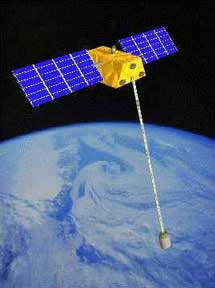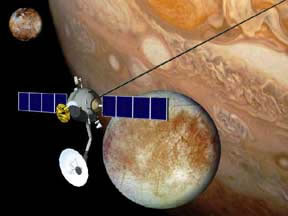Science Fiction
Dictionary
A B C D E F G H I J K L M N O P Q R S T U V W X Y Z
Electrodynamic Tethers: Clean Up Debris - Power or Boost Spacecraft

An electrodynamic tether (EDT) is a simple idea, but one with an amazing number of uses. An EDT system is made up of two masses in orbit connected by a long, flexible, electrically conductive cable; the tether is essentially a wire that moves through the magnetic field of the Earth (or another planet or large body). An EDT takes advantage of two basic principles of electromagnetism: current is produced when a conductive wire moves through a magnetic field, and the field exerts a force on the current. While it is not a colorful as the Rasta space tug from William Gibson's Neuromancer, it could provide a technology that takes low-flying satellites to a new level.

(From NASA Tethered Spacecraft)
An EDT can use these principles in two ways:
- An EDT can generate electric current flow towards the planet; this can provide enough electricity to run experiments on board a satellite; this also causes the tether to experience a force from the planet's magnetic field that is opposite the tether's direction of motion. In other words, it slows the EDT system down (produces drag), lowering the EDT's orbit.
- By adding a battery (or solar panel) to the EDT circuit, the induced current is overcome, reversing the current direction; the force experienced by the tether is now in the same direction as the EDT's motion. In other words, this produces thrust, raising its orbital attitude.
As discussed, this method of creating electrical power has a serious side-effect, namely, that the spacecraft or satellite will experience drag. That is, it will slow down and seek a lower orbit, eventually crashing on the planet. However, there is a way to turn this "bug" into a feature. One problem that is getting worse around Earth is that of discarded "space junk" (see illustration below). This property of EDTs could be used to bring down this junk earlier and in a controlled fashion. At the end of a satellite's life (or a rocket stage, or anything else), it is given a signal to release a long wire antenna. A current will flow in the wire, and the satellite will begin to slow down, quickly heading for burn-up in the atmosphere.

(From Center for Orbital and Reentry Debris Study)
The second use of EDT is really amazing. The International Space Station will require over seventy tons of propellant over the next ten years to keep its orbit from decaying. All of this reaction mass must be hauled up the gravity well at a cost of $7,000 per pound (not $7, as previously stated)! A properly deployed EDT, combined with another power source, could actually push itself forward on the Earth's magnetic field, speeding the IST up without the use of any propellant.
This will have profound implications on missions to other planets, since satellite missions will no longer need to carry expendable propellant to continue their missions. An EDT can be used to alternately boost to a new location, and then reverse current and use the resulting drag force to decellerate and fine-tune its orbit. This greatly extends the useful life of these space probes.

(From NASA Tethered Spacecraft)
So why aren't EDTs in widespread use? The biggest problems are electromechanical; EDTs experience high voltages in space. Also, EDTs are prone to vibrations that produce significant mechanical forces. Also, development has been slow; a program planned for launch in 2004, ProSEDs, was repeatedly postponed and ultimately canceled.
Science fiction author David Brin has made a good story (from 1982) available; you might want to go read Tank Farm Dynamo. This story is a poignant tale of what might have been in the last century of American space travel. The story takes maybe fifteen minutes to read - it's well worth it! For another spacetug story, see ConeXpress OLEV - Will A Good Tug Save Hubble?.
A lot of the background information for this article was found in Electrodynamic Tethers in Space from the August issue of Scientific American; unfortunately, it's not free. Thanks to yet another alert reader for the scoop on this story.
Long space tethers don't need to be conductive to have unusual effects - take a look at Non-Conductive Tethers - Free Artificial Gravity In Orbit.
Scroll down for more stories in the same category. (Story submitted 11/5/2004)
Follow this kind of news @Technovelgy.| Email | RSS | Blog It | Stumble | del.icio.us | Digg | Reddit |
Would
you like to contribute a story tip?
It's easy:
Get the URL of the story, and the related sf author, and add
it here.
Comment/Join discussion ( 6 )
Related News Stories - (" Space Tech ")
Will Space Stations Have Large Interior Spaces Again?
'They filed clumsily into the battleroom, like children in a swimming pool for the first time, clinging to the handholds along the side.' - Orson Scott Card, 1985.
Reflect Orbital Offers 'Sunlight on Demand' And Light Pollution
'I don't have to tell you about the seven two-mile-diameter orbital mirrors...'
Chrysalis Generation Ship to Alpha Centauri
'This was their world, their planet ó
this swift-traveling, yet seemingly moveless vessel.' - Nat Schachner, 1934
The First Space Warship For Space Force
'Each of the electrical ships carried about twenty men...' - Garrett P. Serviss, 1898.
Technovelgy (that's tech-novel-gee!) is devoted to the creative science inventions and ideas of sf authors. Look for the Invention Category that interests you, the Glossary, the Invention Timeline, or see what's New.
Science Fiction
Timeline
1600-1899
1900-1939
1940's 1950's
1960's 1970's
1980's 1990's
2000's 2010's
Current News
Golf Ball Test Robot Wears Them Out
"The robot solemnly hit a ball against the wall, picked it up and teed it, hit it again, over and again...'
Boring Company Vegas Loop Like Asimov Said
'There was a wall ahead... It was riddled with holes that were the mouths of tunnels.'
Rigid Metallic Clothing From Science Fiction To You
'...support the interior human structure against Jupiterís pull.'
Is The Seattle Ultrasonics C-200 A Heinlein Vibroblade?
'It ain't a vibroblade. It's steel. Messy.'
Roborock Saros Z70 Is A Robot Vacuum With An Arm
'Anything larger than a BB shot it picked up and placed in a tray...'
A Beautiful Visualization Of Compact Food
'The German chemists have discovered how to supply the needed elements in compact, undiluted form...'
Bone-Building Drug Evenity Approved
'Compounds devised by the biochemists for the rapid building of bone...'
Secret Kill Switch Found In Yutong Buses
'The car faltered as the external command came to brake...'
Inmotion Electric Unicycle In Combat
'It is about the size and shape of a kitchen stool, gyro-stabilized...'
Grok Scores Best In Psychological Tests
'Try to find out how he ticks...'
PaXini Supersensitive Robot Fingers
'My fingers are not that sensitive...'
Congress Considers Automatic Emergency Braking, One Hundred Years Too Late
'The greatest problem of all was the elimination of the human element of braking together with its inevitable time lag.'
The Desert Ship Sailed In Imagination
'Across the ancient sea floor a dozen tall, blue-sailed Martian sand ships floated, like blue smoke.'
The Zapata Air Scooter Would Be Great In A Science Fiction Story
'Betty's slapdash style.'
Thermostabilized Wet Meat Product (NASA Prototype)
There are no orbiting Michelin stars. Yet.
Could Crystal Batteries Generate Power For Centuries?
'Power could be compressed thus into an inch-square cube of what looked like blue-white ice'
